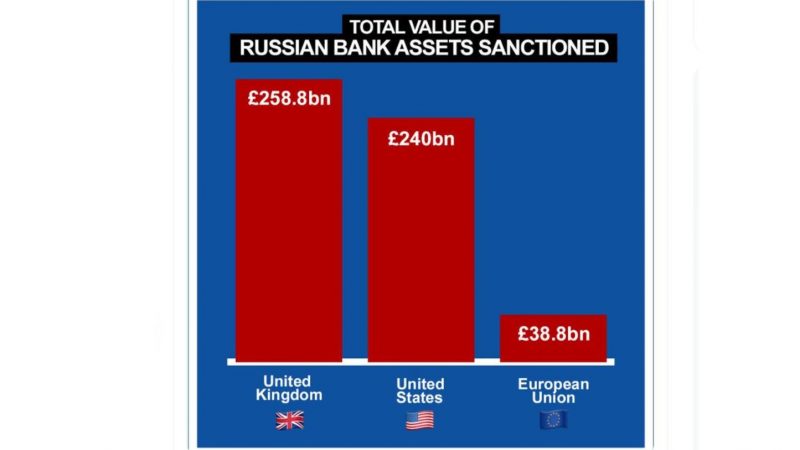The Foreign, Commonwealth and Development Office has not explained how it has calculated figures that claim Britain is ‘leading the way’ in Russian sanctions.

On March 5, several Tory MPs, including the newly appointed Brexit opportunities minister, Jacob Rees-Mogg, made claims that the UK “leads the way” in sanctioning Russian banks.
The Tory MP tweeted a chart alleging the total value of Russian banks assets. It claims the UK has made £258.8bn in sanctions, the US £240bn, and the EU £38.8bn.
The tweet naturally led to ridicule, with the opposition jumping on how the chart shows there is simply more Russian money worth sanctioning in London than elsewhere. As Labour MP Chris Bryant said: “All this proves is that thanks to the Tories all the dodgy Russian money is in London. It’s an admission of corruption!”
Fellow Labour MP Karl Turner added that the cabinet minister’s claim shows the “actual scale of ill-gotten Putin money his utterly disgusting Tory Government have let in.”
Rees-Mogg asked to share the source of the chart
Some Twitter users asked Rees-Mogg to share the source of the chart, with some even sharing a different chart, which claims to show a cross-section of countries that have sanctions ‘entities’ so far. The chart showed the UK had, at the time, sanctioned 16 entities since the war broke out, compared to 118 by the US and 490 by the EU.
In response to Rees-Mogg’s tweet, Full Fact, the UK’s independent fact checking organisation, said they had a lot of readers asking them to check the sanctioning claim.
Full Fact’s verdict is that UK government hasn’t even backed up its Russian sanction claims, as the Foreign, Commonwealth and Development Office (FCDO) has not explained how it has calculated these figures or detailed what they represent. Subsequently, the figures “cannot be verified, and it is unclear whether they are comparable,” asserts Full Fact.
In reply to an email the Full Fact team sent to Rees-Mogg, the cabinet office insisted that the figures were based on statistics by the FCDO that were quoted in an article in the Telegraph.
The Telegraph’s report makes reference to Foreign Office figures that the UK had frozen a total of £258.8 billion of bank assets, compared to £240 billion by the US and £33.8 billion by the EU. The article notes how the figures follow criticism towards the UK government over the speed in which it was imposing sanctions on individuals in Britain linked with Putin’s regime.
The article quotes a Foreign Office source, which told the newspaper: “Liz’s [Truss] focus has been on hitting banks and financial institutions, which have a bigger impact on the Russian economy than sanctioning single individuals. That’s the strategy. We’ve gone further than the EU and US on bank asset freezes, which is where Russia really feels the pinch.”
No further sources quoted
However, as Full Fact notes, what exactly the figures refer to or how they were calculated remains unknown. No evidence of the FCDO publishing the data can be found and no further sources were quoted in the chart of the in the Telegraph article.
When pressed about the figures for more detail, the FCDO simply repeated that £258.8 billion figure was the total value of bank assets designated for sanctions.
Full Fact also questioned why the chart that showed the UK had sanctioned 16 entities which was originally published by Bloomberg and was compiled by a company called ComplyAdvantage, had been removed by the American business and markets news site. Bloomberg failed to respond but a note attached to the article said the chart “inaccurately described UK sanctions.”
The FCDO contends that the information is imprecise, telling Full Fact Bloomberg was “inaccurate” and that “[the] UK has sanctioned 228 individuals, entities and subsidiaries since invasion”.
However, ComplyAdvantage, told Full Fact that it does not believe the figures were inaccurate and that the numbers for the UK were based on its analysis of entities added to the UK Sanctions List since 24 February, when the full invasion of Ukraine began.
As the UK Statistics Authority states: “Policy, press or ministerial statements referring to regular or ad hoc official statistics should be issued separately from, and contain a prominent link to, the source statistics. The statements should meet basic professional standards of statistical presentation, including accuracy, clarity and impartiality.”
By sharing an unsourced chart, both Jacob Rees-Mogg and the Telegraph are failing to adhere to the Code of Practice set out by the UK government’s Statistics Authority. And when using numbers to describe the sanctions placed on Russians, as Full Fact notes, it is important to be very precise indeed.
Gabrielle Pickard-Whitehead is a contributing editor to Left Foot Forward
Left Foot Forward doesn't have the backing of big business or billionaires. We rely on the kind and generous support of ordinary people like you.
You can support hard-hitting journalism that holds the right to account, provides a forum for debate among progressives, and covers the stories the rest of the media ignore. Donate today.



